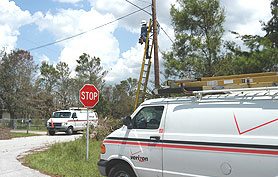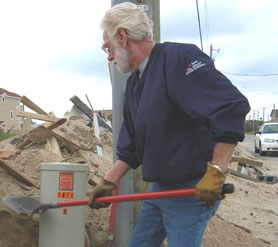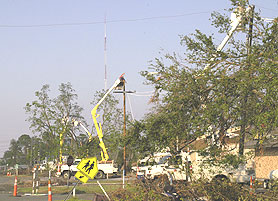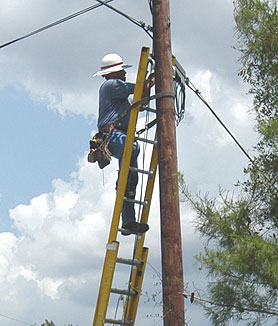Hurricane eMatrix
List of Activity Sheets » Infrastructure repair and restoration
Restoring Communications Systems

This picture shows actual disaster site work conditions and may not illustrate proper safety and health procedures.
Activity Description
- This activity sheet addresses the assessment and restoration of communications systems. For some operations or situations (e.g., permit-required confined space entry, trenching, heavy equipment use) other activity sheets also apply; see related activity sheets linked below.
- As a result of Hurricanes Katrina and Rita (2005), many communities lost their communications systems (e.g., telephones, microwave towers, cable television, Internet service) because the high winds caused communications lines to fail and, in combination with water and sediment, affected switching equipment and support structures.
- Restoration of the communications system infrastructure often requires specially trained and qualified telecommunications workers, sometimes from other areas of the country, to assess and repair the damage area-by-area. This work involves the use of specialized electrical-isolation equipment, frequent use of aerial lifts and ladders, and entry into enclosed and confined spaces.
- Telecommunications workers conducting assessment and repair activities should already be familiar with safe work practices and personal protective equipment applicable to restoring communications services. This activity sheet is intended to remind telecommunications workers and supervisors of some of the hazards and suggested controls appropriate for communications systems restoration activities after a hurricane.
- Telecommunications workers conducting this operation may be employed by Federal, State, local, and private employers. Review How to Use This Matrix in the introduction for a discussion of how this information may apply to different workers.
About the Activity Sheet
This activity sheet does not provide an in-depth analysis of OSHA standards and regulations and cannot address all hazards. It does not increase or diminish any OSHA requirement or employer obligation under those requirements. It is intended as a guide and quick reference for employers and response and recovery workers. The Matrix captures major activities involved in hurricane response and recovery, highlights many of the hazards associated with them, and recommends beneficial work practices, personal protective equipment (PPE), and other exposure control methods. Employers must evaluate the specific hazards associated with the job/operation at the site where the work is being performed.
Employers are responsible for providing a safe and healthful workplace for their workers. OSHA's role is to assure the safety and health of America's workers by setting and enforcing standards; providing training, outreach, and education; establishing partnerships; and encouraging continual improvement in workplace safety and health.
The Hazard Exposure and Risk Assessment Matrix for Hurricane Response and Recovery Work provides a general overview of particular topics related to current OSHA standards. It does not alter or determine compliance responsibilities in OSHA standards or the Occupational Safety and Health Act of 1970, or the equivalent State Plan standards and requirements. Because interpretations and enforcement policy may change over time, you should consult current OSHA/State Plan administrative interpretations and decisions by the Occupational Safety and Health Review Commission and the courts for additional guidance on OSHA compliance requirements. Employers should modify their procedures as appropriate when additional, relevant information becomes available.
Activity-Specific Sampling and Monitoring Information
- Work zone safety concerns were found at over half these work sites where hazards were noted. Typically work areas were not adequately marked or separated with signs, cones or barricades.
- When aerial lifts were used, fall protection was identified as a concern in over half of the work sites observed. Fall protection was not used, or, when used, was not properly anchored.
- For safety and health monitoring data and sample results, see the Summary of Activity Sampling Data and Safety and Health Monitoring Information.
General Recommendations
Key Engineering Controls and Work Practices. See general recommendations document.
Personal Protective Equipment. The general PPE is recommended for all response/recovery tasks/operations; only the additional PPE that may be needed for a specific hazard is noted below.
General PPE includes:
- Hard hat for overhead impact or electrical hazards
- Eye protection with side shields
- Gloves chosen for job hazards expected (e.g., heavy-duty leather work gloves for handling debris with sharp edges and/or chemical protective gloves appropriate for chemicals potentially contacted)
- ANSI-approved protective footwear
- Respiratory protection as necessary—N, R, or P95, filtering facepieces may be used for nuisance dusts (e.g., dried mud, dirt and silt) and mold (except mold remediation). Filters with a charcoal layer may be used for odors
Recommendations Specific to Hazards Associated with Restoring Communications Systems
Key Engineering Controls and Work Practices

- Assume that lines are live power lines until their voltages are tested and proven to be communications lines (lower voltage)
- Ensure that all workers assessing and repairing communications systems are qualified for that work (e.g., first aid trained, understand PPE needs and minimum approach distances)
- Ensure that communication systems lines are properly grounded
- Prohibit climbing and working above the lowest level of electric power conductors unless a rigid fixed barrier is installed between the power and communications conductors or the power conductors carry less than 300 volts and are 40 or more inches below the communications conductors
- Use fall-arrest, work-positioning, or travel-restricting equipment when working more than 4 feet above the ground on poles, towers, or similar structures without fall protection (cages, railings)
Additional Personal Protective Equipment
- Hard hat with appropriate ANSI rating for exposure to voltages expected (as needed)
- Appropriately rated and tested electrician's gloves (as needed)
- Personal fall arrest system including harnesses, lanyards, lifelines, connectors, anchorages, and anchor points (as needed)
Key Engineering Controls and Work Practices
- See Work Zone Safety and Traffic Control within a Work Area activity sheet
Additional Personal Protective Equipment
- ANSI/ISEA 107-2004 compliant high visibility safety apparel and headwear for all workers
Key Engineering Controls and Work Practices
- See Heavy Equipment and Powered Industrial Truck Use activity sheet
- See Crane Use activity sheet
- See Use of Aerial Lifts activity sheet
Additional Personal Protective Equipment
- Hearing protection—see Noise hazard
- When working from an aerial lift, use a body harness that is properly attached (or body belt for tethering or restraint use only) for fall protection
Key Engineering Controls and Work Practices
- Use ground-fault circuit interrupters (GFCIs) or double insulated power tools, or implement an assured equipment grounding program
- Inspect power tool condition (including any cords) and verify operation of safety features before use
- Do not use equipment that is defective, such as equipment with inoperable safety switches, missing guards, frayed/cut cords etc.
- Ground power tools properly
- Avoid standing in wet areas when using portable power tools
Additional Personal Protective Equipment
- Hearing protection—see Noise hazard
- Hand protection for cut- and abrasion-control and vibration dampening
- Eye protection appropriate to the impact hazard
Key Engineering Controls and Work Practices

- During storm work and emergency conditions, telecommunications workers can not perform tree trimming where energized power conductors are involved
- Closely inspect trees for electrical conductors passing through or within reaching distance of workers before beginning tree work
- Consider all electrical power conductors to be energized; do not directly or indirectly touch them (e.g., through tools, branches, or other equipment)
- Before performing work near energized conductors, contact the conductor owner to ascertain any non-readily apparent hazards
- If electrical hazards (e.g., power lines, transformers) are near telecommunications equipment
- Use only qualified workers or trainees who are familiar with the special techniques and hazards involved in line clearance
- If the electrical hazard is 750 V or more, a second worker or trainee qualified in line clearance tree trimming must be within normal voice communication range
- Determine minimum approach distances and appropriate rating for gloves or insulating blankets based on the measured or expected voltages
- Use appropriately rated insulating equipment to remove branches hanging on energized conductors
- Do not contact electrical conductors with ladders or aerial devices, including insulated devices
- See Tree Trimming activity sheet

Key Engineering Controls and Work Practices
- Inspect ladders for cracked, broken, or defective parts before use
- Do not exceed the load rating of ladders—remember that load ratings include people, tools, and equipment
- Set up ladders on stable surfaces
- Ensure that ladders are appropriately supported (ladder hooks) or lashed in place when working with communications system wires or poles
- Set extension or straight ladders at a 75 degree angle from the ground (1/4 foot back for every foot of rise) and provide 3 feet above an upper landing surface to ease climbing onto/descending from height
- Use non-conductive ladders (e.g., fiberglass) and exercise extreme caution when working near power lines
- Secure ladders that can be displaced by work activities; consider barricades at the base to keep traffic away
Key Engineering Controls and Work Practices
- Ensure that a competent person inspects and determines that a supporting structure (pole, platform, ladder, walkway or other elevated structure) is adequately strong, in good condition, and properly secured before workers, materials, or equipment is supported by it. A competent person is able to recognize existing and predictable hazardous conditions and has the authority to take prompt corrective measures to eliminate the hazardous conditions
- Do not climb poles or structures that are not adequately strong or in good condition
- If poles or structures are not considered adequately strong or in good condition:
- Tag them in a conspicuous place
- Secure them by guying, bracing or other means before climbing or accessing them
Key Engineering Controls and Work Practices
- Confined spaces have limited means of entry or exit, are large enough to bodily enter, and may contain physical (e.g., mechanical, electrical, hydraulic, pneumatic energy; engulfment hazards; inwardly converging surfaces) or atmospheric hazards (e.g., atmospheres that are oxygen-deficient or oxygen-enriched, contain or may contain flammable gas, vapor or mist, airborne combustible dust, toxic substances, or any other atmosphere that is immediately dangerous to life or health). Examples include storage tanks, process vessels, bins, boilers, vaults, ventilation or exhaust ducts, sewers, tunnels, pipelines, and pits more than 4 feet in depth
- Hurricane-related events might introduce hazards or potential hazards into confined spaces. For example, a space might have a potential to contain a hazardous atmosphere due to the presence of decomposing organic matter, to the use of hazardous chemicals in the space, or to the performance of operations in the space, such as welding, cutting, or burning, that may create a hazardous atmosphere. Additional precautions must be taken to make the space safe for entry
- Evaluate the need for entry (i.e., placing any body part into the space)
- If entry is required, see Entry into Confined Spaces activity sheet
Key Engineering Controls and Work Practices
- Unless trained, do not enter any area posted with a red and black "Warning: Radio-frequency Radiation Hazard" warning sign
- If trained, follow all administrative and engineering controls to ensure that exposure is maintained below the radiation protection guide
Key Engineering Controls and Work Practices
Additional Personal Protective Equipment
- Based on the initial exposure assessment, select a respirator and protective clothing for visual inspection, sampling, and subsequent abatement work
Key Engineering Controls and Work Practices
- Remove flammable and combustible materials from the area
- Do not perform "hot work" such as welding, cutting, or burning in areas where flammable, combustible, corrosive, or toxic substances are being used, stored, or may otherwise be present
- Maintain a fire watch during all hot work until material has cooled
- Ensure fire extinguishers and extinguishing agents are available in the immediate area
- Provide natural, exhaust, or forced ventilation to control exposure to the metal fumes and other contaminants being generated (e.g., generator exhaust)
- Ensure that pipes and other vessels are purged of hazardous materials
- Identify building materials that will be welded, cut, or burned and that may contain lead, such as painted surfaces and pipes. Test materials and provide exposure controls identified in 29 CFR 1926.62 as necessary; see the lead hazard in the general recommendations document
Additional Personal Protective Equipment
- Gloves and protective clothing for the activity being performed
- At a minimum, filtered lenses and face-protection as appropriate for the activity being performed
- Respiratory protection, based on anticipated exposure to metal fumes, including lead

Key Engineering Controls and Work Practices
- Limit access/set up controlled access zones
- Use fall protection systems: guardrails, safety nets, or fall arrest systems
- Cover or guard holes and openings as soon as they are created. Covers must support two times the weight (body, equipment, materials) that may be imposed
Additional Personal Protective Equipment
- Personal fall arrest system including harnesses, lanyards, lifelines, connectors, anchorages, and anchor points (as needed)
Key Engineering Controls and Work Practices
- See Trenches and Excavations activity sheet
Key Engineering Controls and Work Practices
- Use additional protections, such as a lifesaving skiff and a ring buoy as appropriate
- See Deep-Water Work/Boating Operations activity sheet as needed
Additional Personal Protective Equipment
- All personnel should wear Coast Guard-approved Type I or II personal floatation devices
- Watertight boots with steel toe and insole as needed
Key Engineering Controls and Work Practices
- Never attach a generator directly to the electrical system of a structure unless a qualified electrician has installed a transfer switch for the generator. If the structure's electrical system is not isolated, it may energize the utility's wiring system for great distances and create a risk of electrocution for utility workers and others in the area
- Always plug electrical equipment directly into the generator using the manufacturer's supplied cords or grounded (3-pronged) extension cords that are rated for the total anticipated load
- Do not overload a generator; it can overheat and create a fire hazard
- Ground and bond generators according to the manufacturer's recommendations; ensure that any manufacturer-required connections are secure before using the generator
- Keep the generator dry; protect with a canopy if needed; do not use it in wet or rainy conditions
- Carbon monoxide (CO) is a poisonous, colorless, and odorless gas that is produced by the incomplete burning of the generator's fuel. CO is harmful when breathed because it displaces oxygen in the blood and deprives the heart, brain, and other vital organs of oxygen
- Never use a generator indoors or in enclosed spaces such as garages and basements; opening windows and doors may not prevent CO from building up in those spaces. Do not use a generator outdoors near doors, windows, and vents that could allow CO to enter
- Ensure that a generator has 3 to 4 feet of clear space on all sides and above it to ensure adequate ventilation and cooling
- Before refueling, shut down the generator and allow it to cool
Additional Personal Protective Equipment
- Hearing protection—see Noise hazard
Key Engineering Controls and Work Practices
- Place generators, compressors, and other noisy equipment at a distance or behind a barrier when possible
Additional Personal Protective Equipment
- Hearing protection when working around potential noise sources and when noise levels exceed 90 dBA. A useful "rule of thumb"—if you cannot hold a conversation in a normal speaking voice with a person who is standing at arms length (approximately 3 feet), the noise level may exceed 90 dBA
Key Engineering Controls and Work Practices
- If hazardous chemical containers are found or leaking materials are detected:
- Do not use spark-producing devices (e.g., engines, tools, electronic, and communications equipment) in the immediate area
- Take self-protective measures (i.e., move to a safe distance upwind) and contact hazardous material response personnel for evaluation/removal before continuing work in the area
Additional Personal Protective Equipment
- Evaluate the need to revise protective clothing, respirator, and glove selection
Select any of the following potential hazards that can be associated with this activity in order to access relevant recommendations in the general recommendations document:
- Slips, trips, and falls on working surfaces
- Environmental hazards
Additional Medical Needs
- Follow medical guidance and precautions outlined in the general recommendations document
Additional Training Needs
- Follow general site- and task-specific training guidelines as outlined in the general recommendations document
- All communications systems restoration workers should be qualified in accordance with 29 CFR 1910.268 - Telecommunications
Related Activity Sheets
- Tree Trimming
- Restoring Electrical Utilities
- Restoring Water and Sewer Services
- Deep-Water Work/Boating Operations
- Entry into Confined Spaces
- Heavy Equipment and Powered Industrial Truck Use
- Trenches and Excavations
- Crane Use
- Use of Aerial Lifts
- Work Zone Safety and Traffic Control within a Work Area
Other Resources and References
- 29 CFR 1910.268, Telecommunications. OSHA Standard.
- 29 CFR 1910.1001, Asbestos in General Industry. OSHA Standard.
- 29 CFR 1926.1101, Asbestos in Construction. OSHA Standard.
- Using Aerial Lifts. OSHA Fact Sheet, (2005).
- Procedures for Atmospheric Testing in Confined Spaces. OSHA Quick Card, (2005).
- Storm/Flood and Hurricane Response. National Institute for Occupational Safety and Health (NIOSH) Workplace Safety and Health Topic.
- Confined Spaces. OSHA Safety and Health Topics Page.
- Respiratory Protection. OSHA Safety and Health Topics Page.
- NIOSH Respirator Selection Logic 2004. Centers for Disease Control and Prevention (CDC).
- Using Portable Generators Safely. OSHA Fact Sheet, (2005).
- Manual on Uniform Traffic Control Devices (MUTCD). U.S. Department of Transportation, Federal Highway Administration.

